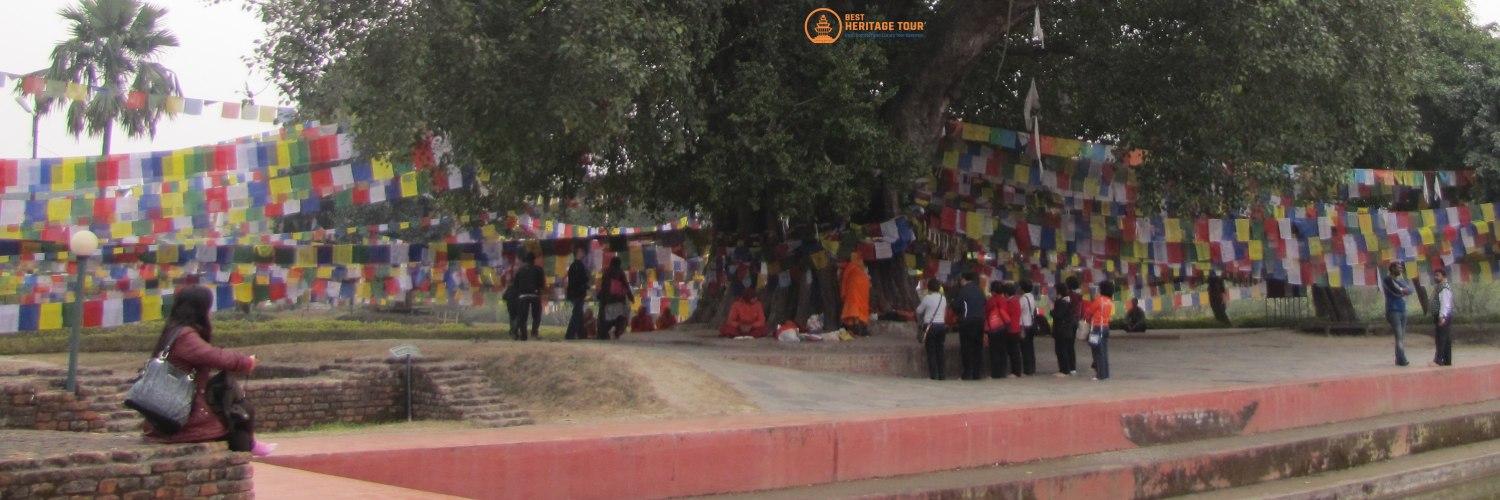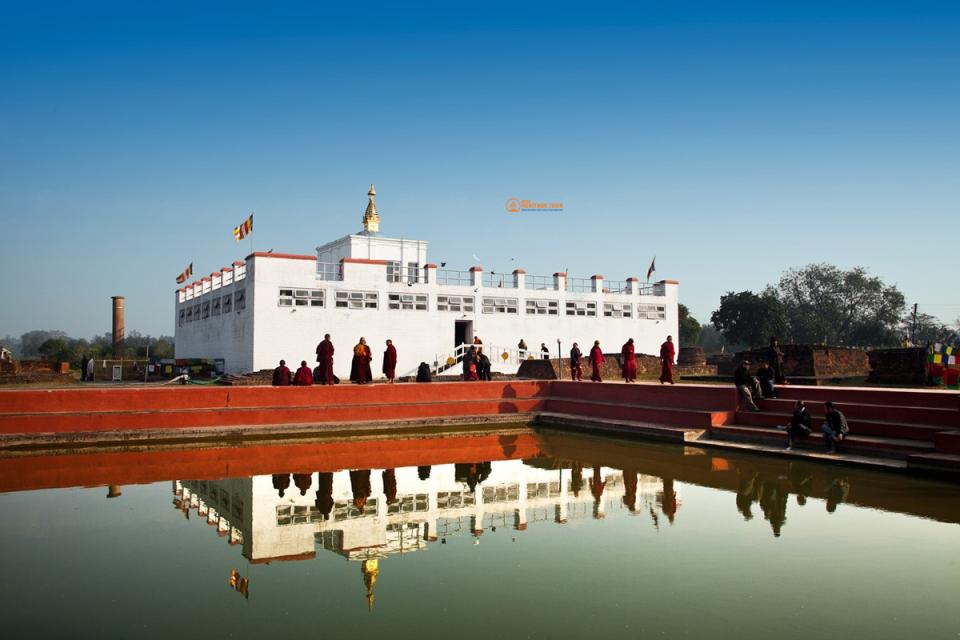Lumbini - the serene birthplace of Lord Siddhartha Gautama Buddha - stands as a timeless symbol of peace, enlightenment, and compassion. Tucked away in the tranquil plains of Rupandehi District, Nepal, this UNESCO World Heritage Site draws pilgrims, travelers, and peace-seekers from every corner of the world. The gentle rustle of prayer flags, the hum of monks’ chants, and the soft glow of monasteries make Lumbini one of the most spiritually powerful places on earth.
But beyond its sacred energy, Lumbini is also a beautifully planned spiritual zone filled with monasteries, meditation centers, archaeological remains, and symbolic monuments built by Buddhist nations around the globe. Whether you are on a spiritual quest or a cultural journey, visiting Lumbini offers you a profound experience of calm and reflection unlike anywhere else in Nepal.
Here are the Top 10 Must-Visit Monasteries and Sacred Sites in Lumbini that you should not miss.
1. Maya Devi Temple - The Heart of Lumbini
At the center of Lumbini lies the Maya Devi Temple, marking the exact spot where Queen Maya Devi gave birth to Prince Siddhartha Gautama around 563 BCE. This sacred sanctuary is the spiritual heart of Lumbini - where history, faith, and archaeology unite.
Inside the temple, visitors can see the ancient marker stone that identifies the birthplace of Buddha, along with remnants of old stupas and shrines dating back over 2,000 years. The surrounding Sacred Garden, adorned with prayer flags and serene ponds, amplifies the sense of peace that envelops the area.
Every pilgrim’s journey begins here - standing before the temple, you can almost feel the weight of time and the awakening of enlightenment.
2. The Sacred Pond (Puskarini)
Just beside the Maya Devi Temple lies the Sacred Pond, known as Puskarini. According to Buddhist tradition, Queen Maya Devi bathed here before giving birth, and baby Siddhartha took his first purification bath in these same waters.
The pond’s stillness mirrors the calm essence of the Buddha’s teachings - serenity, mindfulness, and purity. Many visitors find it a perfect spot for quiet reflection and meditation.
3. Ashokan Pillar - The Emperor’s Legacy
A few steps away from the Maya Devi Temple stands the Ashokan Pillar, a historic monument erected by the great Emperor Ashoka in 249 BCE. It bears an inscription that confirms Lumbini as the birthplace of the Buddha, making it one of the earliest recorded archaeological evidences of Buddhism’s origin.
The pillar remains an unshakable witness to centuries of devotion and symbolizes the spread of Buddhism across Asia. For history enthusiasts and spiritual travelers alike, standing before the Ashokan Pillar feels like touching a fragment of ancient truth.
4. Myanmar Golden Temple (Lokamani Cula Pagoda)
Resembling the grand pagodas of Yangon, the Myanmar Golden Temple - also known as Lokamani Cula Pagoda - gleams with golden spires and ornate carvings. Built by the Burmese government, it represents the Theravada Buddhist tradition and is one of the most visually striking sites in Lumbini.
Inside, visitors can find peaceful meditation halls and Buddha statues that radiate spiritual calm. The surrounding gardens make it a serene spot for travelers seeking both beauty and inner peace.
5. Chinese Monastery (China Temple)
Built in a blend of traditional Chinese architectural style and Buddhist symbolism, the Chinese Monastery is a true masterpiece. The monastery’s red-and-gold hues, curved roofs, and intricate dragon carvings give it a majestic appeal.
Within its tranquil compound, monks chant daily prayers, and visitors can join meditation sessions or simply absorb the temple’s spiritual energy. The Chinese Monastery stands as a beautiful representation of the global Buddhist community’s devotion to Lumbini.
6. Royal Thai Monastery
One of the most elegant and admired monasteries in the Monastic Zone, the Royal Thai Monastery is built entirely from white marble and exudes peace and purity. Its shining façade, reflecting sunlight, symbolizes the clarity and enlightenment found in Buddha’s teachings.
The monastery serves as both a place of worship and a center for Buddhist study. Many travelers visit to meditate in its peaceful courtyard, attend chanting ceremonies, or simply admire the architectural brilliance that bridges Thai artistry with Nepali spirituality.
7. Great Drigung Kagyud Lotus Stupa (German Monastery)
Built under the guidance of the Drigung Kagyu Order of Tibetan Buddhism, the German Monastery or Great Lotus Stupa is a must-see for those interested in Tibetan architecture and Buddhist philosophy.
The white dome, surrounded by beautiful gardens, symbolizes the unity of all beings. Inside, colorful murals depict the life of Buddha and the wheel of life, offering visitors a deep insight into Buddhist cosmology.
This monastery’s quiet atmosphere makes it a favorite spot for meditation and introspection - a sanctuary for the soul.
8. Korean Buddhist Monastery
Simple yet profoundly peaceful, the Korean Monastery reflects minimalist Zen architecture with wooden structures and wide open courtyards. The monks here live a quiet monastic life devoted to meditation and prayer.
Visitors are welcome to join the daily prayer chants or meditate in the monastery’s open hall. The Korean temple reminds visitors that simplicity and mindfulness are at the heart of true spiritual practice.
9. Japanese Peace Pagoda (World Peace Pagoda)
Standing tall on the northern edge of Lumbini, the World Peace Pagoda, also known as the Japanese Peace Stupa, is one of the most iconic landmarks of the area. Built by Japanese Buddhists, this dazzling white stupa symbolizes world peace and harmony.
The dome houses a golden statue of Lord Buddha in the posture of enlightenment. Surrounded by green lawns and pathways, it’s a beautiful place for meditation, sunrise photography, and spiritual reflection. The stupa also serves as a reminder of Nepal’s central role in promoting global peace through Buddhism.
10. Cambodian Monastery
The Cambodian Monastery stands out for its intricate carvings and colorful reliefs depicting stories from the Buddha’s life. With tall spires and ornamental gates, it resembles the temples of Angkor Wat, offering a glimpse of Cambodian Buddhist artistry in the heart of Nepal.
Inside, the golden Buddha statue and peaceful prayer halls make it a perfect place to end your Lumbini monastery tour - in silence, gratitude, and awe.
Why Choose a Guided Tour to Lumbini?
While Lumbini can be explored independently, a guided tour enriches your experience with cultural insight, historical context, and convenience. Local guides help you understand the deep symbolism of each monastery, share legends and stories, and ensure you don’t miss any hidden treasures within the vast monastic complex.
With a trusted travel partner like Best Heritage Tour, you can enjoy a seamless journey - from Kathmandu to Lumbini - complete with comfortable transport, accommodation, and expert guidance tailored to your spiritual and cultural interests.
Conclusion
Lumbini is not just a destination - it’s an awakening. Every monastery, every stupa, and every sacred stone tells a story of peace, faith, and compassion that continues to inspire the world. Whether you’re a devout Buddhist, a history lover, or simply a traveler searching for inner calm, Lumbini offers an experience that touches the heart and soul.
Plan your Lumbini journey today with Best Heritage Tour - your trusted travel companion in Nepal.
Let us take you beyond sightseeing into the true essence of peace and spirituality.
Phone / WhatsApp / Viber: +977-9851149197 | +977-9810043046
Email: info@bestheritagetour.com | bestheritagetour@gmail.com
Info & Booking: www.bestheritagetour.com
Office: Thamel Marg, Kathmandu, Nepal
Author: Best Heritage Tour
Date: 14th October, 2025


